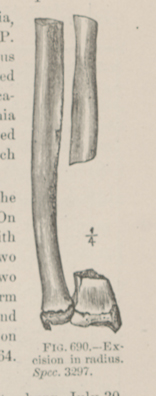Title: Contraman, J.
Source text: The Medical and Surgical History of the War of the Rebellion. (1861-65.), Part 2, Volume 2 (Washington, DC: Government Printing Office, 1876), 951.
Civil War Washington ID: med.d2e30771
TEI/XML: med.d2e30771.xml
CASE 1898.—Private J. Contraman, Co. G, 142d Pennsylvania, aged 20. was wounded at Spottsylvania, May 11, 1864, and admitted to Fairfax Hospital, from a Fifth Corps field hospital, on the 16th. Surgeon D. P. Smith, U. S. V., noted: "Gunshot fracture of left forearm by a minié ball. Excision of three inches of radius performed on the field." On May 18th, the parts being in a gangrenous condition, Surgeon Smith amputated the forearm at the upper third. The patient was extremely irritable. The treatment consisted in the application of pimple dressings, followed by a solution of bromine. Death resulted, on May 27, 1864, from pyæmia following the amputation. The specimen, represented in the accompanying wood-cut (FIG. 690), was forwarded to the Museum by Dr. Smith. It consists of the lower two-thirds of the bones of the left forearm from which three inches of the radius were excised primarily. The age of the patient was probably overestimated.
